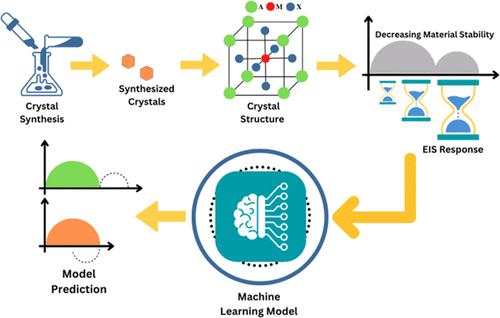当前位置:
X-MOL 学术
›
ACS Appl. Mater. Interfaces
›
论文详情
Our official English website, www.x-mol.net, welcomes your
feedback! (Note: you will need to create a separate account there.)
Probing the Low-Frequency Response of Impedance Spectroscopy of Halide Perovskite Single Crystals Using Machine Learning
ACS Applied Materials & Interfaces ( IF 8.3 ) Pub Date : 2023-06-02 , DOI: 10.1021/acsami.3c00269 Nishi Parikh 1 , Seckin Akin 2 , Abul Kalam 3 , Daniel Prochowicz 4 , Pankaj Yadav 5
ACS Applied Materials & Interfaces ( IF 8.3 ) Pub Date : 2023-06-02 , DOI: 10.1021/acsami.3c00269 Nishi Parikh 1 , Seckin Akin 2 , Abul Kalam 3 , Daniel Prochowicz 4 , Pankaj Yadav 5
Affiliation

|
Electrochemical impedance spectroscopy (EIS) has emerged as a versatile technique for characterization and analysis of metal halide perovskite solar cells (PSCs). The crucial information about ion migration and carrier accumulation in PSCs can be extracted from the low-frequency regime of the EIS spectrum. However, lengthy measurement time at low frequencies along with material degradation due to prolonged exposure to light and bias motivates the use of machine learning (ML) in predicting the low-frequency response. Here, we have developed an ML model to predict the low-frequency response of the halide perovskite single crystals. We first synthesized high-quality MAPbBr3 single crystals and subsequently recorded the EIS spectra at different applied bias and illumination intensities to prepare the dataset comprising 8741 datapoints. The developed supervised ML model can predict the real and imaginary parts of the low-frequency EIS response with an R2 score of 0.981 and a root mean squared error (RMSE) of 0.0196 for the testing set. From the ground truth experimental data, it can be observed that negative capacitance prevails at a higher applied bias. Our developed model can closely predict the real and imaginary parts at a low frequency (50 Hz–300 mHz). Thus, our method makes recording of EIS more accessible and opens a new way in using the ML techniques for EIS.
中文翻译:

利用机器学习探索卤化物钙钛矿单晶阻抗谱的低频响应
电化学阻抗谱 (EIS) 已成为一种用于表征和分析金属卤化物钙钛矿太阳能电池 (PSC) 的通用技术。可以从 EIS 光谱的低频范围中提取有关 PSC 中离子迁移和载流子积累的关键信息。然而,由于长时间暴露在光线和偏压下导致的低频测量时间过长以及材料退化促使人们使用机器学习 (ML) 来预测低频响应。在这里,我们开发了一个 ML 模型来预测卤化物钙钛矿单晶的低频响应。我们首先合成了高质量的 MAPbBr 3单晶,随后在不同的应用偏压和光照强度下记录 EIS 光谱,以准备包含 8741 个数据点的数据集。开发的监督式 ML 模型可以预测低频 EIS 响应的实部和虚部,测试集的R 2得分为 0.981,均方根误差 (RMSE) 为 0.0196。从地面真实实验数据,可以观察到负电容在较高的施加偏压下占优势。我们开发的模型可以准确预测低频(50 Hz–300 mHz)的实部和虚部。因此,我们的方法使 EIS 的记录更易于访问,并开辟了将 ML 技术用于 EIS 的新途径。
更新日期:2023-06-02
中文翻译:

利用机器学习探索卤化物钙钛矿单晶阻抗谱的低频响应
电化学阻抗谱 (EIS) 已成为一种用于表征和分析金属卤化物钙钛矿太阳能电池 (PSC) 的通用技术。可以从 EIS 光谱的低频范围中提取有关 PSC 中离子迁移和载流子积累的关键信息。然而,由于长时间暴露在光线和偏压下导致的低频测量时间过长以及材料退化促使人们使用机器学习 (ML) 来预测低频响应。在这里,我们开发了一个 ML 模型来预测卤化物钙钛矿单晶的低频响应。我们首先合成了高质量的 MAPbBr 3单晶,随后在不同的应用偏压和光照强度下记录 EIS 光谱,以准备包含 8741 个数据点的数据集。开发的监督式 ML 模型可以预测低频 EIS 响应的实部和虚部,测试集的R 2得分为 0.981,均方根误差 (RMSE) 为 0.0196。从地面真实实验数据,可以观察到负电容在较高的施加偏压下占优势。我们开发的模型可以准确预测低频(50 Hz–300 mHz)的实部和虚部。因此,我们的方法使 EIS 的记录更易于访问,并开辟了将 ML 技术用于 EIS 的新途径。











































 京公网安备 11010802027423号
京公网安备 11010802027423号